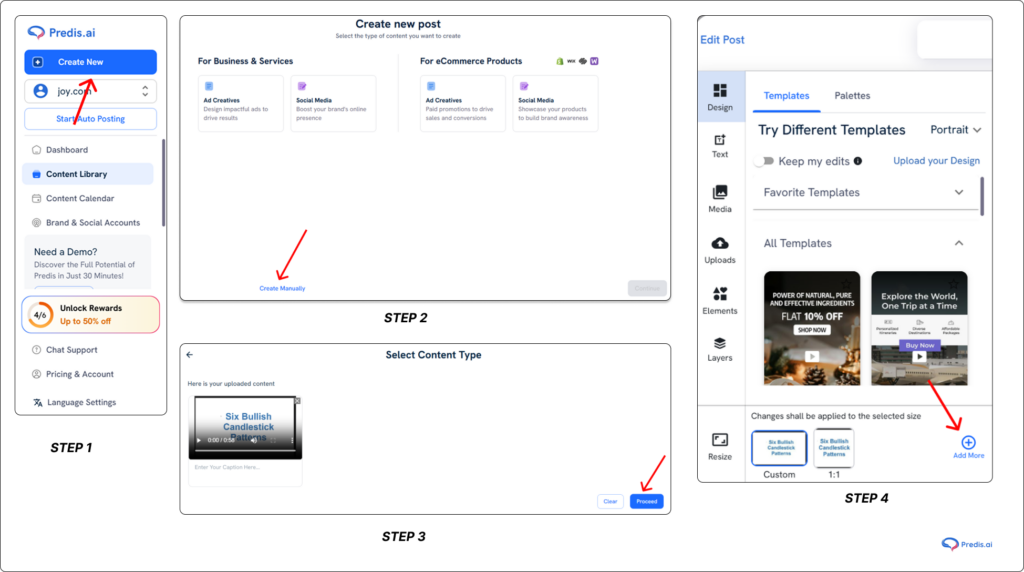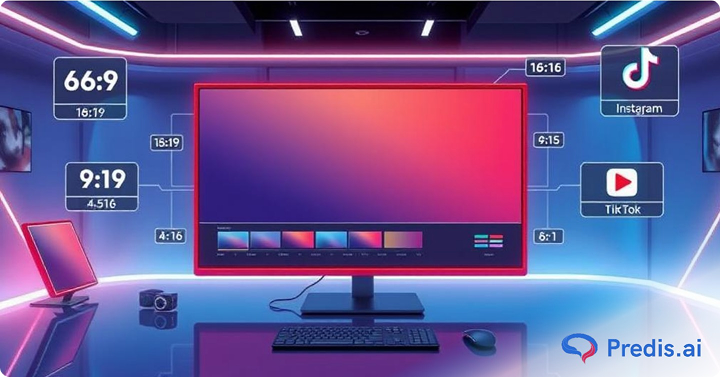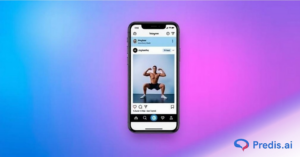Videos are everywhere from YouTube and Instagram to TikTok and Facebook. But have you ever uploaded a video only to find it gets cropped awkwardly or doesn’t display properly? That’s because of the aspect ratio, a crucial factor in video creation.To make your content look good across different platforms, choosing the right aspect ratio is very important. In this complete guide, we’ll break down everything you need to know about aspect ratios. We will explore the best video aspect ratio for each social media platform and how to change them using tools and with best practices.
What is an Aspect Ratio?
An aspect ratio in video is the width and height in proportionate scale. It is stated as width: height (e.g., 16:9 indicates: 16 units as the width and 9 units as the height).
Why Does Aspect Ratio Matter for Videos?
The ideal aspect ratio makes sure the display of your video is flawless and free of odd cropping or black bars. Aspect ratio influences visibility, user experience, and engagement, especially on social media. Users mainly prefer the content that fits into the suggested dimensions. And because of the proper aspect ratio, the reach and interaction increases.
Understanding Video Aspect Ratios
Aspect ratios determine how a video appears on different screens. Some are square (1:1), some are widescreen (16:9), and others are vertical (9:16). Each format suits different viewing habits and devices.
For example, 16:9 is perfect for YouTube and TV, while 9:16 is ideal for mobile-first platforms like TikTok and Instagram Reels.
How Aspect Ratios Impact Video Quality and Viewer Experience?
- A correctly calculated aspect ratio or proper framing of the video makes sure that crucial components are within the frame.
- Videos that follow the platform’s guidelines and standard aspect ratio tend to get more shares and views.
- Incorrect ratios can take away the visual appeal and this often results in zoomed-in information or black bars.

Common Video Aspect Ratios & Their Uses
Different aspect ratios are suitable for different platforms. Let’s explore some of the most commonly used video aspect ratios along with their uses:
1:1 (Square Video)
- This type of video aspect ratio is best suited for Instagram feed, Facebook posts, and LinkedIn
- Such aspect ratios that are square can be used on social media feeds because they take up more screen space. This makes them more engaging.
- One such example depicting square video aspect ratio can be a product demo for Instagram or a short explainer video for Facebook.
16:9 (Widescreen)
- The widescreen aspect ratio is primarily used for sharing videos on YouTube, television, and streaming platforms.
- Since it is the standard format for most video content, it works best for landscape viewing on desktops and TVs.
- This aspect ratio is ideal for posting vlogs, tutorials, or movie trailers on YouTube.
9:16 (Vertical Video)
- Vertical video aspect ratios are used for Instagram Reels, TikTok, YouTube Shorts, Facebook Stories
- This format is optimized for mobile viewing, where people hold their phones vertically to create a vertical video.
- You can use this type of aspect ratio for a trending dance video on TikTok or to show a behind-the-scenes clip on Instagram Reels.
4:5 (Portrait Video)
- 4:5 aspect ratio is best for Facebook and Instagram feed videos
- Portrait videos usually take up more screen space than square videos and are better suited for storytelling.
- A promotional ad on Instagram or a Facebook marketing video should be created in 4:5 aspect ratio.
21:9 (Ultra-Wide Video)
- Ultra wide video are used for creating Cinematic content, film trailers, immersive storytelling
- This ratio should be used to create a movie-like experience but isn’t ideal for mobile platforms.
- You can use ultra-wide video for a short film or high-end commercial

Additional Aspect Ratios
- 2:1 (Univisium): This aspect ratio offers a middle ground between traditional widescreen and ultra-wide formats. It’s gaining popularity in streaming content for its cinematic feel while being more adaptable to various screens.
- 4:3 (Fullscreen): Once the standard for older television broadcasts and computer monitors, this aspect ratio is still relevant for certain artistic choices and retro-themed content.
- 3:2: Originally used in classic 35mm still photography, this aspect ratio has found its way into some video applications, especially in digital cameras that shoot both photos and videos.
Choosing the Right Aspect Ratio for Different Platforms
Each social media platform has its own preferred aspect ratios. Here’s a breakdown:
YouTube
- For Youtube the best video aspect ratio is 16:9 (widescreen)
- YouTube optimizes its platform for landscape videos, which makes 16:9 the default aspect ratio.
- Feed Posts: 1:1 (square) or 4:5 (portrait)
- Reels & Stories: 9:16 (vertical)
- IGTV: 9:16 (full-screen vertical)
- Instagram is mobile-first, so vertical formats perform best.
TikTok
- Best Aspect Ratio: 9:16 (vertical)
- TikTok videos are designed for full-screen vertical viewing.
- Feed Videos: 1:1 or 4:5
- Stories: 9:16
- Square and portrait videos work well in the Facebook feed, while Stories need a vertical format.
Twitter/X
- Best Aspect Ratio: 16:9 or 1:1
- Landscape and square formats work best on Twitter, as users often play videos within tweets.
- Best Aspect Ratio: 1:1 or 16:9
- LinkedIn’s professional audience prefers well-framed, clear videos, hence this aspect ratio is best suited.
Websites and Blogs
- Best Aspect Ratio: 16:9 or 4:3
- These formats make sure that there is compatibility across different screens and this helps to make the videos engaging.
How to Change Video Aspect Ratio?
You can change the video aspect ratios using the below methods. We will explore each of the following methods further below:
- Editing tools and software: You can do this by using different editing tools, because different tools cater to different needs. From professional video production to quick social media edits, you can change the aspect ratio of videos accordingly.
- Cropping vs. resizing vs. adding borders: When changing a video’s aspect ratio, you have three main options. Each has its pros and cons, depending on how you want your video to look.
Predis AI
Predis AI is an all-in-all content creation platform that helps you create, edit, collaborate, schedule, and publish your content. We have everything you need to make your content a success, we did not forget the resize tool as well.
- With Predis AI, you can resize the videos swiftly, easily, and efficiently.
- Select the “Create New” option in the left-hand side menu.If you have your video created already, you can click the “Create Manually” option. Here you can upload the video you created and hit “Proceed”

Adobe Premiere Pro
Adobe Premiere Pro is one of the most capable video editing software options available. You can change aspect ratios manually or with predefined templates.
- Adjust the framing with the Auto Reframe tool to keep the main subject in focus.
- Export in several formats to accommodate diverse systems.
- Ideal for filmmakers, multimedia creators, and professionals seeking high-quality edits.
Final Cut Pro
Final Cut Pro is Apple’s professional-level video editing program. This software works better on Mac. Features include:
- With built-in crop and scale tools, you can easily modify the aspect ratio.
- The Smart Conform tool automatically adjusts video dimensions to multiple formats.
- High-quality rendering for professional video production.
- Ideal for Mac users, professional editors, and YouTube makers.
CapCut
CapCut is a great free mobile editor, perfect for quick aspect ratio changes. It is best for beginners, mobile content creators, and TikTok users. It offers:
- One-tap aspect ratio selection for TikTok, Instagram, and YouTube.
- Drag-and-drop editing for an easy user experience.
- AI-powered cropping to keep subjects in frame.
Canva
It’s not traditional video editor, but it’s perfect for resizing social media clips. Canva is best for marketers, social media managers, and non-tech users looking for quick fixes. Features include:
- Preset templates for Instagram, TikTok, Facebook, and YouTube.
- Simple drag-and-drop interface for resizing and cropping.
- Ability to add branding elements like text and overlays.
How To Crop, Resize & Add Borders?
When changing a video’s aspect ratio, you have three main options. Each has its pros and cons, depending on how you want your video to look.
1. Cropping
- Cuts out unwanted areas to fit a specific ratio, but might also cut out important parts of the video.
- Removes unnecessary background elements.
- Keeps the video visually appealing without stretching.
- Can result in a loss of visual context.
- Adjusting composition when resizing from a wide format (16:9) to a square or vertical format (1:1, 9:16).
2. Resizing
- Stretches or compresses the video to match a new ratio.
- Maintains the entire frame without cutting content.
- Works well for minor adjustments.
- Can distort the video if stretched too much.
- May reduce quality if not done correctly.
- Converting a high-resolution video to a slightly different aspect ratio without losing key details.
3. Adding Borders
- Keeps the original video intact and fills extra space with a background color or blur.
- Prevents distortion and cropping.
- Maintains the full-frame look.
- May not look professional if the borders are too thick.
- Some platforms might auto-crop the video.
- Repurposing widescreen (16:9) videos for vertical formats (9:16) without losing important content.
Best Practices for Using Video Aspect Ratios
Below are some of the best practices that should be used to maintain quality, avoiing black bars or distortion, and repurposing content efficiently, according to the different social media platform needs:
- Choose the right aspect ratio to ensure your videos look great on all devices and stay engaging.
- Use high-resolution footage (4K or 1080p) to maintain clarity when resizing.
- Crop and scale high-quality videos without losing important details.
- Export videos in the highest resolution supported by each platform, such as YouTube supports 1080p or 4K (16:9); Instagram Reels/TikTok uses 1080×1920 pixels (9:16) and Facebook feed supports 1080×1350 pixels (4:5).
- Use professional editing software like Adobe Premiere Pro, Final Cut Pro, or DaVinci Resolve to minimize quality loss.
- Choose the right aspect ratio from the start based on where your video will be published.
- Film with extra space around the subject so you can crop for different formats without losing key details.
- Use smart reframing tools instead of stretching the video.
- Add blurred background borders instead of cropping if your video doesn’t fit the required ratio.
- Keep the main subject centered while filming so it can be cropped into different formats.
- Use built-in templates in editing software to quickly adjust aspect ratios.
- Invest in batch editing—edit once, then export multiple versions for different platforms.
Conclusion
It’s important to pick the right video aspect ratio so that your content looks good, is professional, and works on all platforms. Using the right aspect ratio will make your videos run faster, get more people to watch them, and look great on all devices. So, make sure your movie is set up for the best viewing experience before you hit “upload!”

















